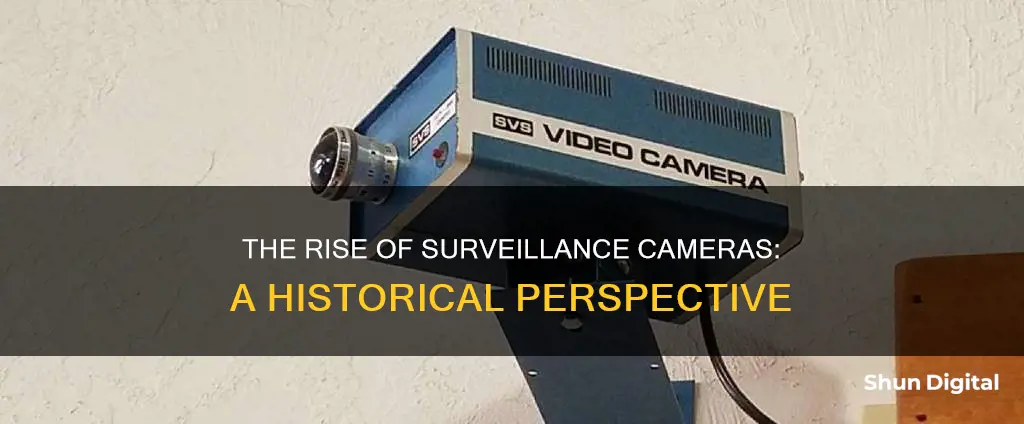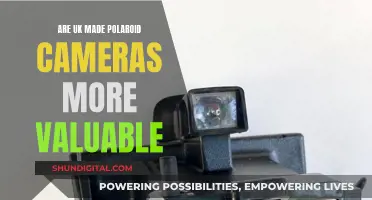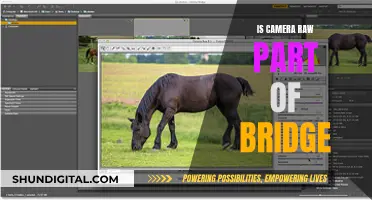
The use of surveillance cameras has become increasingly popular since their invention. The earliest documented use of surveillance technology was in 1942, when the German military used CCTV to observe rocket launches during World War II. In 1949, the first commercially available CCTV systems were sold by the American company Vericon. However, these early cameras were limited in their ability to record footage and required constant monitoring. The invention of the video cassette recorder (VCR) in the 1970s revolutionized the industry, making it possible for businesses and individuals to record security footage and review it at their convenience. The transition to digital recording in the 1980s and 1990s further enhanced the convenience and accessibility of surveillance systems, leading to their widespread adoption in homes, businesses, and public spaces. Today, security cameras are commonplace, with an estimated one billion cameras installed worldwide.
| Characteristics | Values |
|---|---|
| First use of surveillance cameras | 1942, by the German military to observe rocket launches |
| First commercially available surveillance cameras | 1949, by American company Vericon |
| Surveillance cameras become common | 1950s-1970s, with the invention of video cassette recorders (VCRs) |
| First home security system | 1969, by Marie Van Brittan Brown |
| First IP camera | 1996, the Axis NetEye 200 |
What You'll Learn
- The first surveillance system was created by Walter Bruch in 1942 for Nazi Germany to observe rocket launches
- The first publicly available CCTV system was sold by a US company in 1949
- The first home security system was invented by Marie Van Brittan Brown in the late 1960s
- The 1970s saw the integration of CCTV systems with VCRs, allowing footage to be recorded, reviewed, and saved
- The 1990s saw the arrival of the first IP camera, removing the need for a closed-circuit system

The first surveillance system was created by Walter Bruch in 1942 for Nazi Germany to observe rocket launches
The history of surveillance cameras can be traced back to the 1920s, when Russian physicist Léon Theremin is believed to have created a closed-circuit system using a camera and television for Stalin-era Soviet Russia. However, the technology as we know it today is largely attributed to German engineer Walter Bruch, who played a pivotal role in its development.
Walter Bruch, a German electrical engineer and pioneer of German television, invented the world's first closed-circuit television (CCTV) system in 1942. Bruch's system was designed to allow Nazi scientists and military personnel to safely observe the launch of V-2 rockets from the Peenemünde site. This was the world's first long-range ballistic missile programme, and the system enabled them to monitor the launches from inside a bunker at a safe distance.
During World War II, Bruch's closed-circuit television system was a significant advancement in surveillance technology. However, it is important to note that these early systems were limited to live monitoring and did not have the capability to record footage. The technology at the time relied solely on cameras and monitors, without the components necessary for recording.
Walter Bruch's contributions to the field of television and surveillance technology extended beyond his work with the Nazis. In the early 1930s, he was actively involved in the development of television technology, presenting a "people's television receiver" in 1933. He also played a role in the 1936 Berlin Summer Olympics, field-testing the first Iconoscope camera, which was a significant milestone for audiovisual technology.
The earliest CCTV security cameras available to the public were introduced in 1949 by the American company Vericon. These early cameras could only be used for live monitoring and did not have recording capabilities. It wasn't until the invention of the videotape recorder (VTR) in 1951 that the ability to record footage became possible. The first commercially available VTR, the VR-1000, was released in 1956, but its large size and high cost limited its accessibility.
Testing Camera Focus: Tips for Sharp Photography
You may want to see also

The first publicly available CCTV system was sold by a US company in 1949
The history of surveillance cameras starts in the 1920s with the invention of a closed-circuit system by Russian physicist Léon Theremin. However, it wasn't until several decades later that the first publicly available CCTV system hit the market.
In 1949, an American company called Vericon began selling the first publicly available CCTV system. This groundbreaking development made surveillance cameras more accessible to businesses, banks, and private residences, marking a shift away from exclusive military use. The system was designed by CBS Laboratories and marketed as "Vericon" by Remington Rand.
Prior to the introduction of this system, the use of surveillance cameras was largely confined to military applications. For instance, during World War II, the US and German militaries employed CCTV cameras to observe rocket tests from a safe distance. The earliest documented use of CCTV technology for this purpose was in Nazi-controlled Germany in 1942, when an engineer named Walter Bruch designed a system for monitoring V-2 rocket launches.
The first CCTV systems available to the public were basic and lacked recording capabilities, requiring constant monitoring. Despite this limitation, they represented a significant step forward in the evolution of surveillance technology, setting the stage for future advancements that would make surveillance cameras a common fixture in societies worldwide.
The development of the videotape recorder (VTR) in 1951 and its commercial availability in 1956 further propelled the adoption of CCTV systems. The introduction of videocassettes in 1969, which were smaller and more affordable than traditional reels, played a pivotal role in bringing surveillance cameras into the mainstream.
Surveillance Cameras in NYC Apartments: What's Legal?
You may want to see also

The first home security system was invented by Marie Van Brittan Brown in the late 1960s
The history of surveillance cameras dates back to the 1920s, but it was in the late 1960s that the first home security system was invented by Marie Van Brittan Brown, revolutionising the way people protected their homes and setting a precedent for modern security systems.
Born in 1922, Brown worked as a nurse in Queens, New York, often returning home late at night due to long work hours. Her husband, Albert Brown, was an electronics technician with irregular working hours, so she was frequently alone. The couple lived in a high-crime neighbourhood, and the slow response time of the police left Brown feeling vulnerable and concerned for her safety. Motivated by these circumstances, she set out to devise a system that would enable her to identify visitors and promptly notify the authorities if needed.
In 1966, Brown, with the assistance of her husband, created a security system that included four peepholes at different heights, a sliding camera, television monitors, and two-way microphones. This formed a closed-circuit television (CCTV) system for surveillance. The sliding camera, in conjunction with the peepholes, allowed Brown to capture images of people of varying heights. The two-way microphones facilitated communication with visitors, and a remote-controlled mechanism enabled her to unlock the door from a safer distance. Additionally, an emergency button was incorporated, which, when pressed, would activate an alarm and alert the police or security personnel.
On August 1, 1966, Brown and her husband filed for a patent, and on December 2, 1969, they were granted U.S. Patent number 3,482,037. Her invention garnered recognition, including an award from the National Scientists Committee and an interview with The New York Times. Brown's pioneering work in home security laid the foundation for many features that are now integral to modern security systems, such as video monitoring, remote-controlled door locks, push-button alarms, instant messaging to security providers, and two-way voice communication.
Unlocking Camera-Free Mode in Roblox: A Step-by-Step Guide
You may want to see also

The 1970s saw the integration of CCTV systems with VCRs, allowing footage to be recorded, reviewed, and saved
The integration of CCTV systems with VCRs in the 1970s was a significant development in the history of surveillance cameras. This advancement allowed users to record, review, and save footage, marking a new era for surveillance and security systems.
The introduction of videocassettes in 1969 was a game-changer, making surveillance cameras more accessible and user-friendly. These cassettes were smaller and more affordable than traditional reels, allowing for easy and quick replacement. This development paved the way for the widespread adoption of consumer videocassette recorders (VCRs) in 1971.
The integration of CCTV with VCR technology brought surveillance within reach of the general public. No longer was it necessary to have a technician or constantly monitor footage. With VCRs, users could record and review footage at their convenience. This was particularly advantageous for businesses, which could now effectively monitor their premises and protect their assets.
Retail shops and banks were among the first to embrace this technology, installing CCTV systems with integrated VCRs in the mid-1970s and continuing into the 1980s. These early systems were bulky and conspicuous, often resembling shoulder-mounted camcorders. Despite their size, they offered a powerful tool for theft prevention and security.
The impact of this integration extended beyond the business world. Home security systems also benefited from these advancements, with the first patent for a home security system granted to Marie Van Brittan Brown in 1969. Brown, concerned about her safety while home alone, designed an integrated system with a sliding surveillance camera, monitor, and two-way audio. This innovation set a new standard for home security, empowering individuals to enhance their safety.
The 1970s also witnessed the introduction of charge-coupled device (CCD) technology in 1976, enhancing low-light performance and paving the path for true night vision capabilities. This period marked a pivotal moment in the evolution of surveillance cameras, making them more accessible, versatile, and effective for a wide range of applications.
Jump-Starting Your DJI Camera Battery: A Quick Guide
You may want to see also

The 1990s saw the arrival of the first IP camera, removing the need for a closed-circuit system
The first network-attached IP video security camera was introduced by Axis in 1996. This innovative camera used the ethernet network to transmit video signals as digital encoded signals, in place of analog. This meant that footage could be sent wirelessly over a computer network, doing away with the need for a closed-circuit setup.
However, IP cameras were initially slow to gain widespread acceptance. Analog security dealers struggled to grasp the concept, and it was computer dealers who first sold these new IP camera systems. They understood the potential of computers and networking, and their support helped jump-start the decline of closed-circuit CCTV systems.
The 1990s also saw the advent of digital video recorders (DVRs), which further contributed to the shift away from closed-circuit systems. DVRs utilised hard disk drives to capture recorded video, eliminating the need for tapes. These recorders offered large storage capacities for digital video, providing a more convenient and efficient solution.
The introduction of IP cameras and DVRs in the 1990s marked a significant step towards the modern security cameras we know today. Wireless technology and digital recording brought increased flexibility and functionality to surveillance systems, paving the way for the advanced features and capabilities that would be developed in the years to come.
Surveillance Cameras: Benefits and Drawbacks
You may want to see also
Frequently asked questions
There is some evidence to suggest that the first surveillance camera appeared in the 1920s in Stalin-era Soviet Russia. Russian physicist Léon Theremin may have created a closed-circuit system using a camera and television. However, the Kremlin quickly classified it.
The first surveillance system is believed to have been designed by German engineer Walter Bruch in 1942. The system was used by the German military to observe the launch of V-2 rockets at the Peenemünde Airfield during World War II.
The earliest CCTV security cameras available to the public were produced by American company Vericon in 1949. However, these cameras couldn't record and required constant monitoring.
Surveillance cameras became commonplace in the 1970s, with the advent of video cassette recorders (VCRs) and the integration of CCTV systems with VCRs. This allowed businesses and individuals to record security footage, review it later, save it, or record over it.







